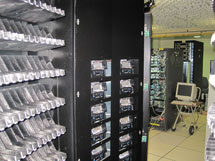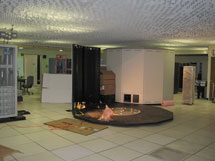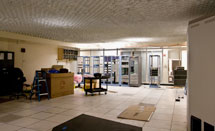
Handy Links
SLAC News Center
SLAC Today
- Subscribe
- Archives: Feb 2006-May 20, 2011
- Archives: May 23, 2011 and later
- Submit Feedback or Story Ideas
- About SLAC Today
SLAC News
Lab News
- Interactions
- Lightsources.org
- ILC NewsLine
- Int'l Science Grid This Week
- Fermilab Today
- Berkeley Lab News
- @brookhaven TODAY
- DOE Pulse
- CERN Courier
- DESY inForm
- US / LHC
SLAC Links
- Emergency
- Safety
- Policy Repository
- Site Entry Form

- Site Maps
- M & O Review
- Computing Status & Calendar
- SLAC Colloquium
- SLACspeak
- SLACspace
- SLAC Logo
- Café Menu
- Flea Market
- Web E-mail
- Marguerite Shuttle
- Discount Commuter Passes
-
Award Reporting Form
- SPIRES
- SciDoc
- Activity Groups
- Library
Stanford
Around the Bay
Spring Cleaning Prepares Building 50 for Expanded Computing Capabilities
Workers removed the last of six data silos last week as part of a push to ready Building 50 for an upgrade to SLAC's computing capabilities. The silos—and their data-handling duties—have already been replaced by two higher-capacity tape storage units that can access data four times faster than the silos did.
The first of the data silos was removed last year. Though construction in the vicinity of the building slowed removal of the other five silos, work has continued in Building 50 on what are termed the core requirements of computing infrastructure—space, power and cooling capacity.
Removal of the silos "represents a critical repurposing of the space," said Norm Ringgold, head of the Computing Division's IT Operations and Infrastructure group. A collaborative effort between this group and SLAC Facilities has resulted in ample space, power and cooling to accommodate computing customer needs, Ringgold said. "Removal of the old data silos provides over 1800 square feet of valuable raised floor space in the Data Center alone."
The old data silos remained in operation for more than 20 years, said Randy Melen, deputy director of SLAC's Computing Division. One silo, dubbed "Johnny 5", got its name from the 1986 movie Short Circuit, while the origin of a second silo's nickname, "Carlos," is lost to Data Center history. They continued to work through several upgrades and improvements in tape formats. The new units should be equally flexible—in fact, Melen said that five-terabyte, or five-trillion-byte capacity tapes are now available, though there's currently no need to replace the one-terabyte tapes in use.
"Tape technology is one of the slowest computing technologies to change," Melen said. "When you have a lot of data—and SLAC has a lot of data—one problem is just moving the data to the new format. We spent most of last year doing just that while also serving the same data to batch systems."
The current storage system matches increases in tape capacity with the ability to add storage capacity to meet increasing demand. This will provide welcome flexibility as SLAC continues its transition to a multi-function lab, according to Melen.
"When SLAC focused on one big experiment like the [SLAC Large Detector] and BaBar it was easier to forecast storage requirements," he explained. "As a multi-purpose lab we have experiments that are either smaller than something like BaBar or are big but run for shorter time periods—but we have lots of them, so it's harder to get a handle on it." With the new storage system in place, SLAC is ready to adapt as the lab's needs evolve.
—Lori Ann White
SLAC Today, April 5, 2011


